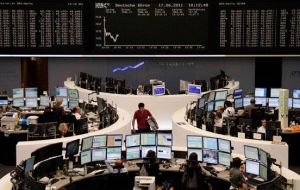MercoPress. South Atlantic News Agency
Fed anticipates no increase in interest rates in the US until late 2014
 The US growth forecast for the current year was cut slightly to a range of 2.2-2.7%, from 2.5-2.9%
The US growth forecast for the current year was cut slightly to a range of 2.2-2.7%, from 2.5-2.9% The Federal Reserve has said it does not now expect to raise interest rates in the US until late 2014. The surprise move announced Wednesday sent the dollar sharply lower in markets, and caused US government borrowing costs to fall.
In its regular policy statement, the central bank said it saw “significant downside risks” to the economy, and said inflation had fallen back to a level in line with its mandate. Rates remain in a target range of zero to 0.25%.
However, some members of the Fed's policy-setting committee, which has just finished a regular two-day meeting, think rates should rise more quickly.
Along with its usual economic forecasts, the Fed decided to publish the interest rate forecasts of individual committee members for the first time.
It revealed that three of the committee's 17 members think rates should rise by the end of this year already, and six members foresee this by the end of 2013. By the end of 2014, six members expect rates to still be at their historic low, while one member expects them to have risen to 2.75%.
The Fed did not announce any new quantitative easing measures - pumping newly created money into the financial system by buying up US government debt and other assets.
However, it repeated a concern expressed in previous statements that the US economy faced “significant downside risks” and that it “expects to maintain a highly accommodative stance for monetary policy”.
The Fed cut its growth forecast for the current year slightly, to a range of 2.2-2.7%, from 2.5-2.9% previously. However, it forecast unemployment would fall to 8.2% - an improvement on its previous 8.5% forecast.
Unlike in previous statements, the Fed also no longer said it was monitoring inflation closely, reinforcing the impression that price rises were no longer a major concern.
The Fed also formalized its inflation target at 2%, similar to the Bank of England's. Previously the central bank did not set itself a formal target, but pointed to a range of 1.7% to 2% as an informal target.
Core inflation - a measure of long-term inflation trends - has fallen back towards 2% in recent months. Consumer prices inflation hit a high of 3.9% last September. However, the Fed's new inflation target is based on the broader personal consumption expenditure (PCE) index.
The interest rate announcement caught markets by surprise. They had been expecting rates to start rising from mid-2014, instead of the late 2014 forecast by the Fed.
The dollar fell, as the lower expected interest rates made the currency a slightly less attractive place to keep cash.
The euro rose one-and a-quarter cents to $1.31 following the release of the statement, which came at the end of a regular two-day meeting of the Fed's policy-setting committee. The pound rose just under a cent to $1.564.
Meanwhile, the US government's implied cost of borrowing in markets for 10 years fell from 2.06% to 1.94%, as traders priced in the lower medium-term interest rate expectations.
The Fed first began stating its expectations about how long it expected interest rates to remain at their historic low back in August last year, as a way of lowering longer-term interest rates and thereby stimulating the economy. Until now, it had been promising to hold rates down until mid-2013.




Top Comments
Disclaimer & comment rulesCommenting for this story is now closed.
If you have a Facebook account, become a fan and comment on our Facebook Page!